Local economy
■ Cardiff, the major economic driver for Wales, is set to see rail electrification complete in 2018, and train journeys to London Paddington will fall to just 113 minutes.
■ This, coupled with the new City Deal document, outlining a programme of investment amounting to £1.2 billion is anticipated to unlock significant economic growth across the Cardiff Capital Region and will help stimulate both occupational and investor demand.
■ The city is set to see positive employment growth (2%) over the next five years. Encouragingly, this is up from the initial post-Brexit forecast and will drive a steady level of demand for office space. This has already been witnessed with companies such as Julian Hodge Bank expanding their workspace from 10,000 to 16,000 sq ft.
■ However, if we drill down to sector level, the Administrative (6.8%) and Tech (6.1%) sectors are forecast to be the real drivers going forward, providing the fastest office based growth over the next five years, as tech based companies look to join the BBC in moving to Cardiff.
Occupational Market
■ Take-up in the Cardiff market has performed strongly, reaching 478,173 sq ft at the end of the third quarter, 34% above the long term average of 355,962 sq ft for this point in the year. This also marked the strongest third quarter on record in the Cardiff market, with no signs of a post-Brexit slowdown, as many feared.
.jpg)
.jpg)
.jpg)

.jpg)